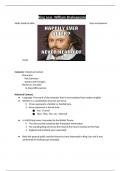Samenvatting
Summary 3.6 Landforms and Landscapes of Coastal erosion AQA Physical Geography
- Vak
- Instelling
- Boek
Key notes on Unit 3.6 Landforms and Landscapes of coastal erosion in AQA Physical Geography A level. Includes key definitions and diagram etc and provided a final A* grade.
[Meer zien]













